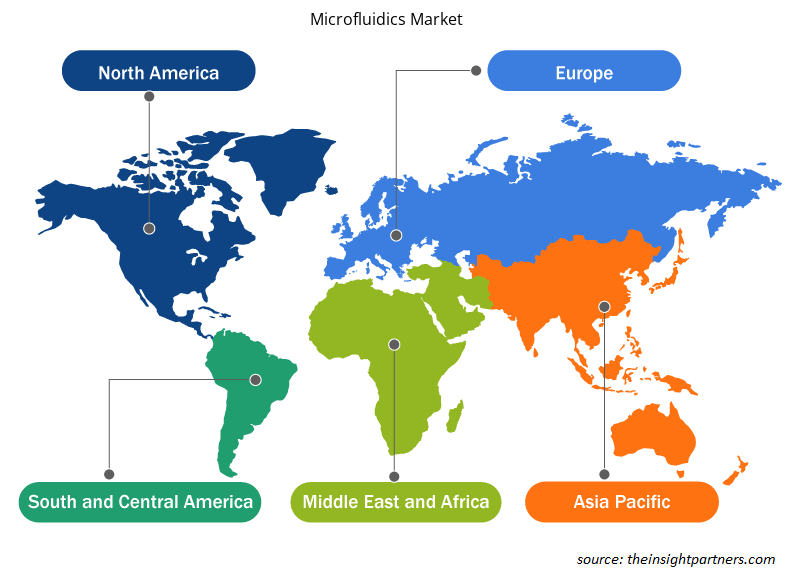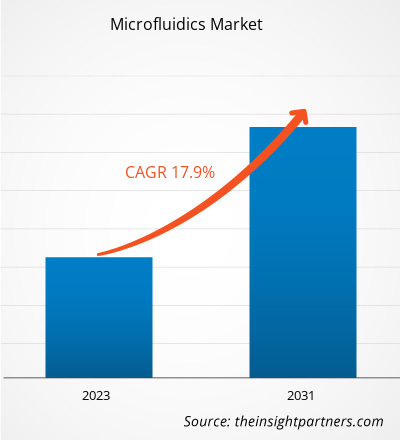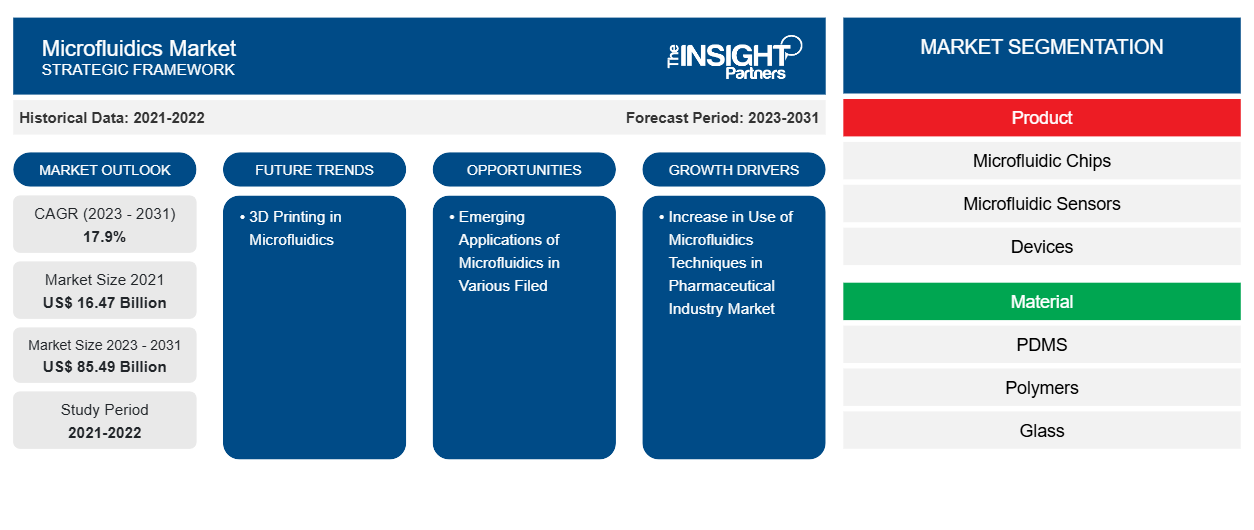マイクロ流体市場は2021年に164億7,000万米ドルと評価され、2031年までに854億9,000万米ドルに達すると予想されています。市場は2023年から2031年にかけて17.9%のCAGRを記録すると予想されています。マイクロ流体における3Dプリンティングは、今後も主要な市場トレンドであり続けると思われます。
マイクロ流体市場分析
マイクロ流体市場は、バイオテクノロジー、医療、ヘルスケアの用途により急速に拡大しています。小型化、自動化、高スループット機能は重要な要素です。市場のプレーヤーには、ポイントオブケア検査、薬物送達、診断などの分野で先駆的な地位を確立している企業や新興企業が含まれます。北米とヨーロッパは、研究への強力な投資と研究インフラがあるため、主要な地域です。AIやIoTなどの他のテクノロジーとの統合により機能と効率性を向上させることは、市場の新たなトレンドの1つです。
マイクロ流体市場の概要
マイクロフルイディクスには、マイクロチャネル内の流体の挙動に関する科学と、流体を流したり閉じ込めたりするためのトンネルやチャンバーを備えた超小型デバイスを製造する技術という 2 つの研究分野が含まれます。マイクロフルイディクスの分野では、フェムトリットル (fL)、つまり 1 リットルの 1000 兆分の 1 という小さな流体量を扱います。マイクロメートル スケールでは、流体は現実世界の流体とはまったく異なる挙動を示します。これらの特性は、新しい科学的発見や実験にとって重要です。今日、マイクロフルイディクスは、さまざまな研究分野、特に生物学的分析に効果的な機器を提供しています。エンド ユーザー向けに合理化および統合された完全な生物学的プロセス、高スループット、マルチプレックス化、および高並列化によるアッセイ、反応と分離の時間が短縮されるため分析が迅速化、ポイント オブ ケア環境で使用できるポータブル ツール、最小限の試薬使用量、分析あたりの全体的なコストの削減、マイクロフルイディクスによる正確な測定。特定のアプリケーションでの測定解像度の向上など、これらはマイクロフルイディクスが提供する利点です。これにより、マイクロ流体の需要が高まり、市場の成長が促進される可能性があります。
要件に合わせてレポートをカスタマイズする
このレポートの一部、国レベルの分析、Excelデータパックなど、あらゆるレポートを無料でカスタマイズできます。また、スタートアップや大学向けのお得なオファーや割引もご利用いただけます。
-
このレポートの主要な市場動向を入手してください。この無料サンプルには、市場動向から見積もりや予測に至るまでのデータ分析が含まれます。
マイクロ流体市場の推進要因と機会
製薬業界市場におけるマイクロ流体技術の利用増加
製薬業界では、新しい医薬品を見つけて提供するために、パーソナライズされた医療に多数のマイクロ流体プロセスを取り入れています。マイクロ流体デバイスは、ターゲットの選択、臨床試験、化学合成、製剤研究、製品管理など、プロセスのさまざまな段階を加速できます。医薬品の研究開発には多額の費用がかかるため、これらの開発は最終的に消費者の役に立ち、市場の成長を促進する可能性があります。microfluidic processes in personalized medicine to find and deliver novel medications. Microfluidic devices can accelerate numerous stages of the process, such as target selection, clinical trials, chemical synthesis, formulations studies, and product management. Given the high expense of drug R&D, these developments might eventually help consumers and drive market growth.
さまざまな分野におけるマイクロ流体の新たな応用 - マイクロ流体市場におけるチャンス
学術研究において、マイクロ流体工学は、エンジニアと細胞生物学者が協力する学際的な分野であり続けています。これらのパートナーシップの目標は、細胞培養実験を継続的に改善することです。逆に、バイオメディカル部門は、マイクロ流体工学をかなり活用し始めたばかりです。マイクロ流体デバイスは、新しい治療薬や医療診断の研究と作成における最近のいくつかの重要な進歩に使用されています。たとえば、単純な血液検査の場合、マイクロ流体デバイスを使用すると、必要な血液が少なくなり、処理時間が大幅に短縮されます。研究開発チームも、マイクロ流体技術を使用して新薬をテストしています。したがって、マイクロ流体技術の応用が増加することで、市場に十分な機会が生まれる可能性があります。
マイクロ流体市場レポートのセグメンテーション分析
マイクロ流体市場分析の導出に寄与する主要なセグメントは、製品、技術、材料、およびアプリケーションです。
- 治療の種類に基づいて、製品市場はマイクロ流体チップ、マイクロ流体センサー、デバイス、マイクロポンプ、マイクロニードル、その他の製品に分かれています。デバイスセグメントは2023年に大きな市場シェアを占めました。
- 材料別に見ると、市場はPDMS、ポリマー、ガラス、シリコン、その他の材料に分類されています。PDMSセグメントは2023年に市場で最大のシェアを占めました。
- アプリケーション別に見ると、市場は体外診断、製薬および生命科学研究、創薬、その他のアプリケーションに分類されています。体外診断セグメントは、2023年に市場で最大のシェアを占めました。
地域別マイクロ流体市場シェア分析
マイクロ流体市場レポートの地理的範囲は、北米、アジア太平洋、ヨーロッパ、中東およびアフリカ、南米/中南米の 5 つの地域に分かれています。
マイクロ流体市場は北米が優勢を占めています。北米では、米国が2023年にマイクロ流体の最大の市場となります。この地域の市場は、研究開発活動の増加、技術進歩の早期導入、主要企業による多額の投資によって予備的に推進されています。たとえば、2021年5月、酵素タンパク質および遺伝子合成技術を生み出している急成長中のバイオテクノロジー企業であるNucleraと、電子インク技術の業界パイオニアであるE Inkは、E Inkのデジタルマイクロ流体部門が新しく設立された米国子会社Nucleraに買収されたと発表しました。
マイクロ流体市場の地域別洞察
予測期間を通じてマイクロ流体市場に影響を与える地域的な傾向と要因は、Insight Partners のアナリストによって徹底的に説明されています。このセクションでは、北米、ヨーロッパ、アジア太平洋、中東およびアフリカ、南米および中米にわたるマイクロ流体市場のセグメントと地理についても説明します。

- マイクロ流体市場の地域別データを入手
マイクロ流体市場レポートの範囲
| レポート属性 | 詳細 |
|---|---|
| 2021年の市場規模 | 164.7億米ドル |
| 2031年までの市場規模 | 854.9億米ドル |
| 世界のCAGR(2023年~2031年) | 17.9% |
| 履歴データ | 2021-2022 |
| 予測期間 | 2023-2031 |
| 対象セグメント |
製品別
|
| 対象地域と国 |
北米
|
| 市場リーダーと主要企業プロフィール |
|
マイクロ流体市場のプレーヤー密度:ビジネスダイナミクスへの影響を理解する
マイクロ流体市場は、消費者の嗜好の変化、技術の進歩、製品の利点に対する認識の高まりなどの要因により、エンドユーザーの需要が高まり、急速に成長しています。需要が高まるにつれて、企業は提供を拡大し、消費者のニーズを満たすために革新し、新たなトレンドを活用し、市場の成長をさらに促進しています。
市場プレーヤー密度とは、特定の市場または業界内で活動している企業または会社の分布を指します。これは、特定の市場スペースに、その規模または総市場価値と比較して、どれだけの競合相手 (市場プレーヤー) が存在するかを示します。
マイクロ流体市場で事業を展開している主要企業は次のとおりです。
- アジレントテクノロジー株式会社
- BD
- バイオ・ラッド・ラボラトリーズ
- ダナハー
- ドロマイト マイクロフルイディクス (Blacktrace Holdings Ltd.)
- フルーダイム株式会社
免責事項:上記の企業は、特定の順序でランク付けされていません。

- マイクロ流体市場のトップキープレーヤーの概要を入手
マイクロ流体市場のニュースと最近の動向
マイクロ流体市場は、主要な企業出版物、協会データ、データベースを含む一次および二次調査後の定性的および定量的データを収集することによって評価されます。以下は、マイクロ流体市場の動向と戦略のリストです。
- 先進的な細胞療法の開発と製造の変革に取り組んでいる革新的なマイクロ流体企業である CellFE Inc. は、急速な細胞圧縮と再膨張を利用して標的ペイロードを細胞内に能動的に輸送する Infinity Mtx 細胞工学プラットフォームの商用提供を発表しました。CellFE のマイクロ流体細胞工学プラットフォームの利点には、編集された細胞の高収量、細胞の回復と膨張時間の短縮、多様なペイロードの効率的な取り込みなどがあり、静脈から静脈への時間の短縮と製造コストの削減につながります。(出典: CellFE Inc 社名、プレスリリース、2023 年)
- コネクタとセンサーの世界的リーダーである TE Connectivity は、マイクロ流体カートリッジとブリスター試薬パッケージの開発、ユーザビリティテスト、臨床研究、製造に重点を置く 3 つの企業を買収しました。(出典: TE Connectivity 社名、ニュースレター、2021 年)
マイクロ流体市場レポートの対象範囲と成果物
「マイクロ流体市場の規模と予測(2021〜2031年)」レポートでは、以下の分野をカバーする市場の詳細な分析を提供しています。
- 対象範囲に含まれるすべての主要市場セグメントの世界、地域、国レベルでの市場規模と予測
- 市場の動向(推進要因、制約、主要な機会など)
- 今後の主な動向
- 詳細なPEST/ポーターの5つの力とSWOT分析
- 主要な市場動向、主要プレーヤー、規制、最近の市場動向を網羅した世界および地域の市場分析
- 市場集中、ヒートマップ分析、主要プレーヤー、最近の動向を網羅した業界の状況と競争分析
- 詳細な企業プロフィール
- 過去2年間の分析、基準年、CAGRによる予測(7年間)
- PEST分析とSWOT分析
- 市場規模価値/数量 - 世界、地域、国
- 業界と競争環境
- Excel データセット
最新レポート
お客様の声
購入理由
- 情報に基づいた意思決定
- 市場動向の理解
- 競合分析
- 顧客インサイト
- 市場予測
- リスク軽減
- 戦略計画
- 投資の正当性
- 新興市場の特定
- マーケティング戦略の強化
- 業務効率の向上
- 規制動向への対応























 無料サンプルを入手 - マイクロ流体市場
無料サンプルを入手 - マイクロ流体市場